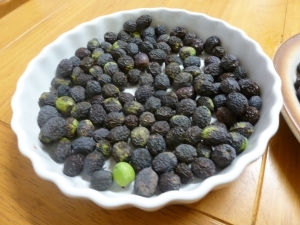
These olives were picked early October 2014. In just 2 weeks they were fully dehydrated and some were ready to be eaten.
Olives ….. you either love them or hate them. Despite industry’s best efforts at enhancing their appeal with anchovy and other fillings, herbs and spices, salt by the bucketful, the potency of olive flavour drives mankind in opposite directions: you’re either hooked on them, or sent to a point of repulsion, seemingly never to return. I’ve noticed a trait in some of those repulsed individuals whom are brave enough to face their fears and sample Borruix unprocessed tree olives. These individuals display bemusement that they can comfortably stomach them, and in significant quantities. Welcome to the world of Borruix raw and unprocessed ‘tree’ olives.
When asked what freshly-picked-off-the-tree olives taste like, as it so often is on olive websites, the reply focuses on the extreme bitterness. And truly bitter they are. I can’t imagine anyone liking olives straight from the tree until near fully ripened. Try one, and you will really appreciate the olive is indeed a fruit. But a bitter fruit, with only a tiny hint of sweetness. However, at this level of ripeness they are losing texture. If you try to eat any more than four or five the mushiness can be quite off-putting. Wild olives are highly palatable, in my opinion. Being significantly smaller than their cultivated siblings, they possess a stronger physical composition, and are less prone to trauma. Pick a handful from the tree and start chewing. Expel the pips and you are left with something I describe as a leathery chewing gum. Quite tasty.
Even if you can tolerate the bitterness, that’s not in itself the problem. Indeed, there is plenty of nutritional science out there which suggests bitter foods are incredibly healthy for our organs, and should make up part of our normal diet. The problem is the numbing sensation left around your mouth, like visiting the dentist on a bad day. They also impart an awkward dry-mouth sensation. Speech becomes slurry and difficult for several hours. Our primary goal therefore, in curing olives naturally, is to neutralize whatever causes these sensations.
How does the food processing industry deal with numbing and dry-mouth? They leach out the oleuropein carbohydrate compound, said to cause the bitter sensations, using a solution of sodium hydroxide. Sodium Hydroxide, called ‘lye’ in said industry, is known to ordinary folk as drain cleaner. Imaging that potency at work in a drain, eating its way through the grease and grime, dissolving it into a watery nothing. So much nourishment being destroyed. Colorants and oil leaching continually. I’ve seen this in my own trials and experiments. I’ve observed continual oozing of oil and colorant into periodically refreshed brine solutions. Go oil prospecting: take an olive and suck away the brine. Squash it a little to expel more solution, until it appears a little dry, and fibre is beginning to tear. Now, using your fingers, and under sunlight, squeeze the olive and search for oil. All I’ve ever struck doing this is a frothy white emulsion. This is bad news: olive oil is highly resistant to emulsification, which is why old-time navies used it to lubricate their steam engines, so just imagine what the industrial processing has done to the oil. In the oilmaking industry, olives and their oil must be dealt with lovingly during the whole production cycle, else the health benefits are lost. For example, the oilmaker must never subject the oil to a temperature greater than 25 degrees celsius – and this is spoken like religion amongst olive oil lovers. During pasteurization, supermarket olives see near four times that temperature. Interesting that olive oil is put out as a wondrous health food, yet you never see olives being advertised in any such light.
Borruix dehydrated tree olives undergo transformation through their own biology, with practically zero human intervention. We set up the condition whereby the process is initiated, and nature does the rest. Only water is removed. In just two weeks the brave can start eating, but I recommend leaving them a month – until all green, inside and out, has turned brown. Gradually all the phenolic flavours emerge, and in your mouth, they feel like medicine. The oil content is maintained 100% pure and unadulterated. That should really mean something to the nutrition conscious amongst us. Even when the olive flesh is totally dry and crumbly them little things are busting with oil when squeezed hard between the fingers. Importantly they are free from odour and foul taste. That’s a clear sign microbes have been kept at bay, and strong indication the oil itself has not gone rancid.
I have accustomed myself to the enjoyment of consuming dehydrated tree olives. It didn’t take long, I recall, something like three olives. That’s typical for even someone new to olives: all it takes is two or three olives for one to know whether they love or hate. And that’s with supermarket olives. I recently tried some commonly branded olives for research purposes. They tasted bland and rancid. Personally speaking, I’m hooked on my leathery tree olives, and I doubt I will ever buy supermarket olives again. Borruix tree olives are grown for sharing. If they appeal to your curiosity please browse my website and get in touch.
Johnny Fitzsimmons
30th December 2014
